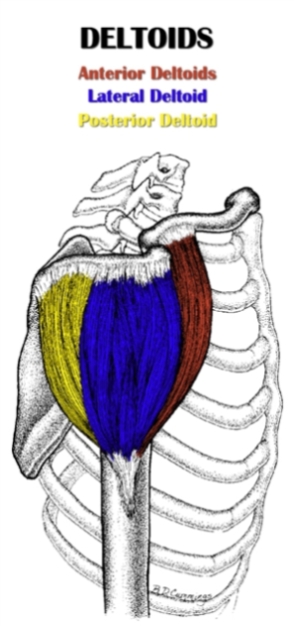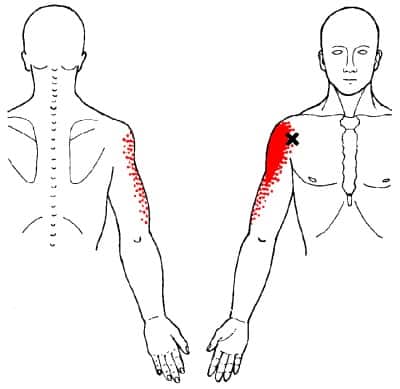 The anterior deltoid (L. anterior, before, in front of ; deltoides, triangular) refers to the front head of the deltoid muscle.
The anterior deltoid (L. anterior, before, in front of ; deltoides, triangular) refers to the front head of the deltoid muscle.
This part of the delt is responsible for shoulder flexion.
Classified as part of the scapulohumeral (intrinsic shoulder) muscle group, the anterior deltoid is situated medial to the lateral deltoid and lateral to the clavicular head of the pectoralis major.
It’s in the outermost layer of muscle, lying superficial to the proximal end of the biceps brachii short head, pectoralis minor and coracobrachialis.
It arises from the lateral third of the clavicle and inserts on the on the outside upper arm at the deltoid tuberosity.
The fibers of the anterior deltoid have a parallel orientation and run inferiorly from origin to insertion.
Also Called
- Anterior delt
- Anterior head of the deltoid
- Front deltoid
- Front delt
- Front of the shoulder
Origin, Insertion, Action & Nerve Supply
| Muscle | Origin | Insertion | Action | Nerve Supply |
|---|---|---|---|---|
| Anterior Deltoid |
Anterior surface of lateral third of clavicle | Deltoid tuberosity of the lateral humerus |
|
Axillary nerve (C5-C6) |
Exercises:
Note: The chart below only shows exercises that work the anterior deltoid directly. However, the anterior deltoids get a significant amount of indirect work from chest exercises (e.g. bench press, push up, dip, fly), especially upper chest exercises (i.e. any incline press or fly).
| Type | Name | Picture |
|---|---|---|
| Barbell: |
 Tutorial: N/A
 Tutorial: N/A
 Tutorial: N/A
 Tutorial: N/A
 Tutorial: N/A
 Tutorial: N/A
 Tutorial: N/A
|
|
| Dumbbell: |
 Tutorial: N/A
 Tutorial: N/A
 Tutorial: N/A
 Tutorial: N/A
 Tutorial: N/A
 Tutorial: N/A
|
|
| Cable: |
 Tutorial: N/A
 Tutorial: N/A
 Tutorial: N/A
 Tutorial: N/A
 Tutorial: N/A
 Tutorial: N/A
|
|
| Machine: |
 Tutorial: N/A
 Tutorial: N/A
 Tutorial: N/A
 Tutorial: N/A
 Tutorial: N/A
|
|
| Bodyweight: |
 Tutorial: N/A
 Tutorial: N/A
 Tutorial: N/A
|
Stretches & Myofascial Release Techniques:
Stretches
| Name | Picture |
|---|---|
 Tutorial: N/A
 Tutorial: N/A
 Tutorial: N/A
|
Self Myofascial Release Techniques
When using these techniques, give special attention to the trigger point shown in the image below.
| Tool | Picture |
|---|---|
 Tutorial: N/A
 Tutorial: N/A
|
Common Issues:
- Overactive/Short Anterior Deltoid: The anterior delt is overactive and short in people with upper crossed syndrome (UCS). One of the many postural characteristics associated with UCS is excessive shoulder internal rotation. The anterior deltoid is facilitated by the internal rotation, which puts it in a chronically shortened state. A major contributor to UCS is overuse of the upper body pushing muscles – including the anterior deltoid – due to an overemphasis on upper body push exercises (e.g. bench press, overhead press, chest fly) and poor postural habits (i.e. hunching over).
Training Notes:
- If your anterior delts are overactive and short, the following advice may help correct this issue.
- Decrease training volume or frequency on anterior deltoid exercises, and completely cut out all front delt isolation movements (i.e. stop doing any front raise variations).
- Decrease training volume or frequency on chest exercises, especially incline chest exercises.
- Increase training volume or frequency on rear deltoid exercises to balance your anterior and posterior shoulder musculature.
- Increase training volume or frequency on the mid back/scapular stabilizer muscles (i.e. horizontal row variations for rhomboids/mid traps; scapular wall slides, forearm wall slides and scap push ups for lower traps/serratus anterior).
- Do soft tissue work on your anterior deltoid and pectoralis major/pectoralis minor. You should stretch these muscles, too, unless you have shoulder joint issues. For example, if you experience anterior humeral glide when bringing your upper arm behind your back, it’s probably wise avoid stretching these muscles altogether; this way, you don’t further stretch out your shoulder capsule, or potentially irritate your rotator cuff tendons or biceps tendon.
- It may be a good idea to do some rear delt soft tissue work, but do not stretch it.
- Limit the time spent in positions that activate and shorten the front deltoid. This means you need to be conscious of your posture when sitting and standing. Try to avoid hunching over and internally rotating the arms, which is the default position for many people when typing on a computer, using a smartphone or playing video games, among other activities. Instead, stand or sit up straight and keep your arms at neutral rotation whenever possible. When this isn’t possible, take a short break (even if it’s only a 2 second break) every 20 minutes or so get out of the bad posture, move around or change positions.
- For most people, the above pieces of advice will only help lengthen/inhibit your short/overactive anterior deltoid to a limited extent. To fully and permanently fix your front delt imbalance, you need to strike at the root of the problem. Chances are the root of the problem is upper crossed syndrome (UCS), even if it’s a minor case of it. To fix UCS and the many muscular imbalances and other problems associated with it, refer to my guide on how to correct upper crossed syndrome (article coming soon).
- If your anterior deltoids are not overactive/short, and your goal is to make them bigger and stronger, the tips outlined below are for you.
- For many people, if you’re already doing a several sets of other pressing exercises (i.e. any bench press variations, dips), then doing any direct front deltoid work will have little to no additional size or strength benefits.
- At most all you need is one big compound shoulder exercise. I recommend the overhead press or push press, but if you have sufficient mobility/flexibility, then switch it up every once in a while and do the behind the neck press since it involves the lower traps and serratus anterior more, which are often underdeveloped and important for healthy shoulders. Whichever compound shoulder exercise you do, make sure you choose a standing variation, since they provide the very important functional benefit of training your core and improving balance with an overhead load. Whereas, seated press exercises completely remove that benefit – And considering that direct shoulder work may not even provide additional strength/size benefits for the anterior deltoid versus chest/horizontal pressing movements, it’s important to choose exercises that will definitely give you some other important benefit.
- Since it is questionable as to whether compound shoulder exercises (e.g. overhead press) actually have any additional benefit over horizontal press exercises (e.g. bench press) in terms of anterior deltoid development, doing a purely isolation exercise (e.g. front raise) in addition to all these compound movements is even less likely to have a positive effect. However, the front raise may be worthwhile to include in your routine since it recruits the lower traps and serratus anterior as synergists, both of which are commonly underdeveloped. So even if the front raise doesn’t contribute to additional anterior deltoid growth, it can still improve scapular stability and overall shoulder health.
- On average, the anterior deltoid consists of an approximately even ratio of slow twitch to fast twitch muscle fibers. Generally, this means they may respond a little better to moderately heavy weight for moderate reps (i.e. 6-12). However, it is important to remember the point that I’ve been stressing in the above bullet points: the anterior delt most likely receives maximum size and strength stimulation from chest/triceps-dominant pressing movements. This being the case, the moderate weight/rep range isn’t necessarily the optimal choice. For example:
- Overhead press and push press are probably more effective when done for heavier weight and lower reps (i.e. 3-6 reps) since lifting heavier loads overhead is more effective for developing core strength and improving the functional skill of lifting and holding objects overhead; that said, it’s wise to use lighter weight and more moderate reps (e.g. 5-10) when first learning the overhead press or push press.
- The front raise is generally most effective when done for moderate to light weight for moderate to high reps (e.g. 8-15+ reps). Using such relatively light weight allows you to perform the movement without being tempted to use momentum. Also, you can more readily activate the lower traps and serratus anterior when lifting your arm above parallel; if you were using heavier weight, these muscles may be too weak to carry out their function.
- Don’t neglect the training the lateral and posterior heads. They are actually more important than the anterior deltoid when it comes to getting the coveted 3-D boulder shoulder look.
- The anterior deltoid – really, the entire deltoid – is a common spot for trigger points. As such, it’s important to stay up on soft tissue work for your entire deltoid, in order to maintain mobility and prevent an imbalance from occurring between the different heads. I personally find that using a lacrosse ball against a wall is the most effective way to release trigger points in the anterior deltoid (you can use the lacrosse ball against the wall or the floor for the lateral and posterior heads). However, if you’ve never done this before, you may find a foam roller to be more tolerable.
- The following tips apply to the overhead press and push press:
- Don’t make the common mistake of excessively arching your lower back to get the weight over your head. Your torso should remain upright throughout the movement, which requires keeping your abs and glutes tight. If you simply can’t prevent your lower back from arching excessively, even with light weight, then stop trying to do the movement until you improve your shoulder mobility and/or core strength. In the meantime, do an incline bench press variation if you still feel you need a compound anterior delt exercise in your routine.
- Avoid using leg drive on the overhead press. If you use leg drive, then you’re effectively doing a push press.
- Use a shoulder width grip and make sure to keep your elbows in.
- Use a thumbless grip. This allows you to keep your elbows in and takes stress off the shoulder or wrist joints.


